Abstract
A critical study of the herbarium material representing the orchid genus Dactylorhiza Necker ex Nevski in Kazakhstan was conducted in 2019–2020. The information on the species composition was clarified. Dactylorhiza fuchsii subsp. hebridensis (Wilmott) Soó and D. × kerneri (Soó) Soó were identified for the first time in the country. New taxa were noted for individual botanical and geographical areas. All taxa were presented in the list and annotated with studied herbarium materials from the Kazakhstan area. Based on the collected and available locations for the studied taxa, distribution modeling was carried out for the four taxa (D. incarnata, D. majalis subsp. baltica, D. salina, and D. umbrosa). Bioclimatic data for the present and future (2041–2060) based on four possible scenarios were used. The occurrence of Dactylorhiza representatives in Kazakhstan is threatened by global climate warming. It is likely that some of them may not occur in the country in the future (D. incarnata and D. majalis subsp. baltica), losing up to 99.87% of their modern range or their range may be significantly reduced (D. salina and D. umbrosa), losing up to 80.83% of their present distribution. It is worth considering global changes in planning conservation activities and identifying areas that may play a significant role in the functioning of the national flora in the future.
Keywords:
climate change; critical review; ENM; floristic novelties; herbarium collections; taxonomy 1. Introduction
The generic name Dactylorhiza was first used by Necker in 1790 [1]. It was officially re-established much later by Nevski [2]. In 1935, he [3] distinguished it from the genus Orchis, a group of species with palmate tuberoids (vs. ovoid or globose), cauline leaves (vs. basal, rosette-forming), herbaceous leafy bracts (vs. scale-like), and the usual number of chromosomes 2n = 40 (vs. 2n = 36, 42) [4,5]. The number of Dactylorhiza species varies depending on the authors [6,7,8,9]. Databases list from over 660 [10] to over 720 names in the genus [11]. Representatives of Dactylorhiza are difficult in determining species affiliation due to their high propensity for hybridization and morphological variability [12,13,14,15,16,17]. Most of the species occupy a wide range of habitats, usually humid, from the slopes of dunes to alpine meadows, including swamps, peatbogs, and various types of forest [12] in the Northern Hemisphere, in Eurasia, northern Africa, and North America.
The flora of Kazakhstan consists of approximately 6000 species and subspecies of vascular plants and is characterized by a significant dissimilarity and originality of the floristic composition of different regions, as well as large endemicity of taxa [18,19]. According to Abdulina [18], the genus Dactylorhiza in the flora of Kazakhstan includes nine species, making this genus the most numerous in the country among the representatives of Orchidaceae.
The vast territory of the Republic of Kazakhstan, located in the center of Eurasia, is extremely diverse in terms of natural conditions [18]. An important zonal boundary passes here, dividing the cold-temperate territories of Northern Eurasia and the hot-temperate territories of the ancient Mediterranean basin [18,19]. The country’s territory is represented by a variety of morphological structures: plains of various origins, sandy massifs, as well as uplands and low mountains in places. Moist areas only remain in mountainous regions. Mountain systems, such as Altai, Tien Shan, and Sauro-Tarbagatai, are connected here [20]. Thus, the ecogeographical character of Kazakhstan is not overly suitable for Dactylorhiza species.
Kazakhstan experiences hot and dry summers and cold winters, which may be indicative of a continental climate. Within the country, temperature variation is very high, with the greatest variation between mountains and deserts [20]. High temperatures and the low annual precipitation, which is less than 100 mm in the deserts and 250 mm to 350 mm in the steppes, contribute to the phenomenon of desertification in Kazakhstan. Unfortunately, the eastern and southeastern parts of the mountain are also highly susceptible to natural disasters such as frosts, droughts, heavy rainfall, hail, floods, mudslides, landslides, and avalanches [21,22]. Climate change, but also the significant pattern of natural disasters seen in Kazakhstan in recent years, is having a significant impact on biodiversity. Wetlands and swamps are the most vulnerable to high temperatures and a very dry climate. Importantly, forests and steppes are also at risk, and are likely to be destroyed by the aforementioned increasing natural disasters [23]. The diverse terrain and prevailing climatic conditions contribute to the diversity of Kazakhstan’s flora. The flora is of global importance for biodiversity due to its high level of endemism, the presence of endangered species and medicinal plants [21]. Unfortunately, habitat loss and degradation, desertification, unregulated deforestation, wetland drainage and poor irrigation practices, overgrazing of livestock, overuse of pesticides and herbicides, and industrial pollution pose serious threats to flora, including Dactylorhiza [22,24,25].
Despite the many threats posed by human activity and its impact on nature, in this case vegetation, one of the most discussed today is anthropogenic climate warming. An increasing number of studies have pointed to climate change as the cause of change for entire vegetation formations [18,26,27]. Some of the most threatened are mountainous areas and areas at risk of desertification, such as many parts of Kazakhstan [21,22,28,29]. As a group of numerous specialists, orchids seem to be under even greater threat in light of the changes taking place. Research has indicated that many groups of orchids are threatened by the disappearance of niches suitable for their survival [25,30,31,32], or the phenomenon of niche shifts is observed [29]. However, it is not understood how such species will survive in the long term, because global warming can also have an effect on, for example, the occurrence of suitable pollinators [33]. Although research has indicated that not all species will be negatively affected by climate change and there are orchids that could potentially increase their range [34,35].
The main objective of this paper is a critical revision of principal herbarium collections to clarify species composition and distribution of the genus Dactylorhiza in Kazakhstan. Species of Dactylorhiza, which are generally linked with humid areas, are especially prone to climate warming and desertification. Based on gathered records, we performed analyses to visualize changes in the distribution of suitable niches of studied taxa caused by global warming.
2. Materials and Methods
2.1. Taxonomic Treatment
The basis for this report was the herbarium collections stored in the Herbaria of the Institute of Botany and Phytointroduction (AA), V.L. Komarov Botanical Institute of the Russian Aacademy of Sciences (LE) and the Depository of Moscow State University (MW) [36,37], with rich gatherings from the territory of modern Kazakhstan and collected by, i.e., N.V. Pavlov, I.M. Krasheninnikov, V.P. Goloskokov, M.M. Ilyin, N.V. Shipchinsky, B.K. Shishkin, V.P. Drobov, F.N. Rusanov, and V.V. Sapozhnikov. The taxa listed were identified based on the cited literature and by a comparative method using the herbarium material in the herbaria visited. According to the botanical zoning of Pavlov in the Flora of Kazakhstan [38], the territory of the country is divided into twenty-nine floristic areas and seven subareas (Figure 1).

Figure 1.
Map of floral zoning of Kazakhstan. 1. Spurs of the General Syrt; 2. Tobol-Ishim; 3. Irtysh; 4. Semipalatinsk pinery; 5. Kokchetav; 6. Caspian; 6a. Bukeyev; 7. Aktobe; 7A. Mugodzhary; 8. Emba; 9. Turgai; 10. Western upland; 10a. Ulutau; 11. East upland; 11a. Karkaraly; 12. Zaysan; 13. Northern Ust-Urt; 13A. Buzachi; 13B. Mangyshlak; 14. Aral; 15. Kzyl Orda; 16. Betpak-Dala; 17. Muyunkum; 18. Balkhash-Alakol; 19. South Ust-Urt; 20. Kzyl-Kum; 21. Turkestan; 22. Altai; 23. Tarbagatai; 24. Dzungarian Alatau; 25. Ile Kungei Alatau; 25A. Ketmen Terskey Alatau; 26. Chu-Ili mountains; 27. Kyrgyz Alatau; 28. Karatau; 29. Western Tien Shan.
Geographical names of the mountain ranges are indicated according to the Physical Map of Kazakhstan. Latin names are given according to the International Plant Name Index [11].
Original labels of new locations are cited, indicating the ecology of growth, date of collection, and surname of the collector, as well as a reference to the storage location.
2.2. Ecological Niche Modeling
Ecological niche modeling (ENM) was conducted using the maximum entropy method implemented in MaxEnt version 3.3.3k [39,40] based on species presence observations. Input data were climatic variables in 2.5 arc minutes (± 21.62 km2 at the Equator) according to Hijmans et al. [41] and Booth et al. [42], and were provided by WorldClim (version 2.1, www.worldclim.org (accessed on 10 March 2021). Considering the outputs of previous studies [43], the area of ENM analyses was restricted to 12° W–139° E and 22°–71° N. The correlation between 19 available bioclimatic variables was calculated using the Pearson correlation coefficient, and the final dataset consisted of 10 layers (Table 1), for which the calculated correlation coefficient factor was lower than 0.8.

Table 1.
Bioclimatic variables used in the ecological niche modeling.
Predictions of the climatic niches for future coverage were modeled using climate projections of the National Center for Meteorological Research, Météo-France, and CNRS laboratory based on the Coupled Model Intercomparison Project Phase 6 (CNRM-CM6-1; Ref. [44] for four Shared Socio-economic Pathways (SSPs): 126, 245, 370, and 585 [45,46,47], which illustrate the level of greenhouse gas emissions based on various adopted global climate policies [48,49]. We chose the time frame 2041–2060 as it is not far away, so it is relatively the most reliable, but it is also sufficient to observe the occurrence of changes related to climate warming.
In all analyses, the maximum number of iterations was set to 1000 and the convergence threshold was set to 0.00001. The “random seed” option, which provided a random test partition and background subset for each run, was applied; 10% of the samples were used as test points. The run was performed as a bootstrap with 1000 replicates, and the output was set to logistic. The evaluation of the created models was carried out using the most common metric—the area under the curve (AUC) [50,51].
Operations on GIS data were carried out on ArcGIS 10.6.1 [52] and QGIS 3.10.6 A Coruña [53]. All maps were cropped to the Kazakhstan area and are presented as such, but the resulting maps of the entire range within the modeling are available as supplementary material for present (Figure S1) and future models (Figures S2–S5).
2.3. Species Presence Data
The four taxa noted in Kazakhstan were used for modeling studies. Dactylorhiza fuchsii subsp. hebridensis and D. × kerneri were excluded due to their still unclear and debatable taxonomic status, and D. magna was excluded because it was not possible to gather an adequate list of sites for analysis. The database of localities was prepared based on sites confirmed in Kazakhstan as a result of our research (Table S1) and data downloaded from GBIF (Table S2) [54]. GBIF occurrence data were manually pre-cleaned and all data with errors were deleted, and only records georeferenced with the precision of at least 2 km were used. To reduce bias caused by sampling in more accessible areas [55,56,57], the database was further rarefied in the number of localities. SDMtoolbox 2.3 for ArcGIS was used for deleting duplicate data and spatially rare data at climate heterogeneity [58,59]. The final database, 1162 of D. incarnata, 131 of D. salina, 68 of D. umbrosa, and 155 of D. majalis subsp. baltica, which was more than the minimum number of records required to obtain reliable predictions in MaxEnt [60,61].
2.4. Changes in the Distribution of Suitable Niches
SDMtoolbox 2.3 for ArcGIS [62] was used to visualize changes in the distribution of suitable niches of studied taxa caused by global warming. Before comparison, the maps were clipped to the Kazakhstan area and then converted into binary rasters and projected using Asia-Albers EAC. The presence threshold for all studies taxa was set to 0.5. The resulting maps show changes in distribution in four categories which are range expansion and contraction, no occupancy (absent in present and future models), or no change (present in both). For D. majalis subsp. baltica, the grid with the maximum potential distribution was used to analyze the change in distribution to see the trend in change; in the others, no areas reached the 0.5 threshold.
3. Results
3.1. Taxa New for the Flora of Kazakhstan
3.1.1. Dactylorhiza fuchsii subsp. hebridensis (Wilmott) Soó, Nom. Nov. Gen. Dactylorhiza: 8 (1962). ≡ Orchis hebridensis Wilmott, J. Bot. 77: 192 (1939). ≡ Dactylorhiza hebridensis (Wilmott) Aver., Bot. J. 71: 92 (1986). ≡ Dactylorhiza maculata subsp. hebridensis (Wilmott) H.Baumann and Künkele, Mitt. Arbeitskreis Heimische Orchid. Baden-Württemberg 20: 631 (1988). ≡ Dactylorhiza fuchsii var. hebridensis (Wilmott) R.M. Bateman and Denholm, Watsonia 17: 340 (1989)
- = Orchis maculata L. var. meyeri Reichenb., Icon. Fl. Germ. 13–14: 67 (1851).
- = Orchis maculata var. cornubiensis Pugsley, J. Bot. 78: 178 (1940). ≡ Dactylorhiza fuchsii var. cornubiensis (Pugsley) Soó, Nom. Nov. Gen. Dactylorhiza: 8 (1962).
- = Dactylorhiza fuchsii f. alpina Landwehr, Orchideeën 37: 78 (1975). ≡ Dactylorhiza fuchsii var. alpina (Landwehr) R.M. Bateman and Denholm, Watsonia 17: 341 (1989).
This taxon has been originally described from the Hebrides, an archipelago west of Scotland and, during the past few decades, it has been treated as endemic to the British Isles. Averyanov [63] was the first to expand its geographical range as far east as Siberia and decided to change status of this taxon to species rank. The taxonomic status of this subspecies, however, requires further study. In many respects, it is similar to nominal subspecies of D. fuchsii and originally described within its boundaries; therefore, we decided to maintain this position before extensive research confirms its status.
Habitat and general distribution: It grows in forest glades, meadows, sparse pine and pine-birch forests, forest swamps, river pebbles, and stream exit points. In Averyanov’s [63] study, the species is found from the archipelago of the Hebrides, through northern Europe and Siberia to Mongolia.
Distribution in Kazakhstan: It has not been reported in the flora of Kazakhstan [64] yet, and it is a new record for national flora. According to herbarium data, it has been found in the Karkaraly and Altai regions (Figure 2):
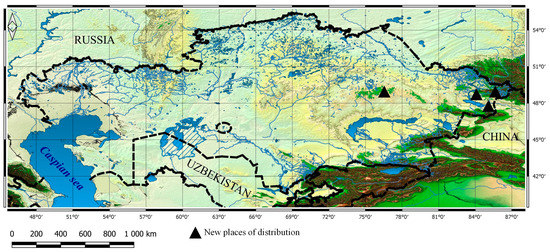
Figure 2.
Distribution of Dactylorhiza fuchsii subsp. hebridensis (Wilmott) Soó (L.) Soó in Kazakhstan.
Karkaraly: forest meadows in a valley, under a forest canopy of pine and birch, 21.VI.1890, Korzhinsky s.n. (LE!).
Altai: Listvyaga ridge, south Siberian floristic expedition of the Academy of Sciences of the USSR, Chernovaya river, a tributary of Bukhtarma river, birch-fir forest, 22.VI.1931, B.K. Shishkin and G. Sumnevich (LE!); Kurchum ridge, near Lake Markakol, near the village Elovka, spruce forest, 4.VII.1908, A.N. Sedelnikov (LE); Kurchum ridge, Lake Markakol, neighborhood of the village Urunkhayka, 2.VII.1908, V. Reznichenko (LE!).
3.1.2. Dactylorhiza × kerneri (Soó) Soó, Nom. Nov. Gen. Dactylorhiza: 9 (1962). ≡ Orchis × kerneri Soó Notizbl. Bot. Gart. Berlin-Dahlem 9: 904 (1926), as ‘kerneriorum’
- = Orchis × ambigua A. Kern., Verh. K. K. Zool.-Bot. Ges. Wien 15: 205 (1865), nom. illeg.
This nothospecies is a widespread offspring of D. maculata (L.) Soó and D. incarnata (Druce) Soó, which in some European localities can replace both parent species, but in other areas individuals are single and very rare [65].
Habitat and general distribution: It grows in the valleys of rivers and streams. It occurs from Europe to Siberia, where populations of the parental species overlap as a hybrid taxon.
Distribution in Kazakhstan: Taxon has not been reported in the flora of Kazakhstan so far [19,64,66,67,68,69,70,71,72,73,74,75,76,77,78,79,80,81,82]. According to available herbarium data, it has been found in East upland, Zaysan, and Altai (Figure 3):
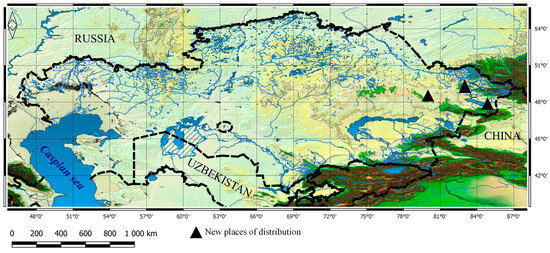
Figure 3.
Distribution of Dactylorhiza × kerneri (Soó) Soó in Kazakhstan.
East upland: Semipalat, botanical expedition led by M.M. Ilyin, East part, in the valley, the village of Kriushi, meadow along a stream, 21.VI.1928, M.M. Ilyin and A.O. Heinrichson (LE!).
Zaysan: Zaysan Depression, Zaisan expedition 1914 of V.V. Sapozhnikov, valley of the Kendyrlik river, near the village Kendyrlik, 4.VI.1914, B.K. Shishkin (LE!).
Altai: Kalba ridge, southern part, eastern part of Kandygatay Mountain, the upper reaches of the Kikuntai-Kara-Su river, at the top, gorge, 17.V.1914, N.V. Shipchinsky (LE!); Kalba ridge, forest in the upper reaches of the Kyzyl-Chilik River, in moist meadows, by the river along moss bumps, in birch-aspen communities, 17.V.1914, N.V. Shipchinsky (LE!).
3.2. New Taxa for Particular Botanical and Geographical Areas
3.2.1. Dactylorhiza incarnata (L.) Soó, Nom. Nov. Gen., Dactylorhiza: 3 (1962). ≡ Orchis latifolia L., 941, excl. var. (1753); Kuznetsov and Pavlov, Fl. Kaz. 2: 271 (1958). ≡ Orchis incarnata L., Fl. Suec., ed. 2: 312 (1755). ≡ Orchis mixta var. incarnata (L.) Retz., Fl. Scand. Prodr.: 167 (1779). ≡ Orchis latifolia var. incarnata (L.) Coss. and Germ., Fl. Descr. Anal. Paris, ed. 2: 684 (1861). ≡ Orchis latifolia subsp. incarnata (L.) Hook.f., Student. Fl. Brit. Isl.: 353 (1870). ≡ Dactylorchis incarnata (L.) Verm., Stud. Dactylorch.: 65 (1947)
This widespread taxon is locally quite common. According to various authors, it is highly variable and several infraspecific taxa have been recognized. However, as a species, it is unquestionably accepted and relatively easy to identify within the genus Dactylorhiza.
Habitat and general distribution: It grows in the humus banks of rivers, mountain streams, water meadows, glades, lowlands, rarely forest edges, and intermountain troughs. The native range of this species extends across Europe throughout the Caucasus and Asia Minor to Siberia and the Himalaya region.
Distribution in Kazakhstan: In the flora of Kazakhstan [64,67], it has been noted in regions such as Tobol-Ishim, Irtysh, Karkaraly, Altai, Tarbagatai, and Dzungarian Alatau. According to available herbarium data, it was first found in Semipalatinsk pinery, Kokchetav, Mugodzhary, Emba, Turgai, East upland, Ile Kungei Alatau, and Karatau (Figure 4):
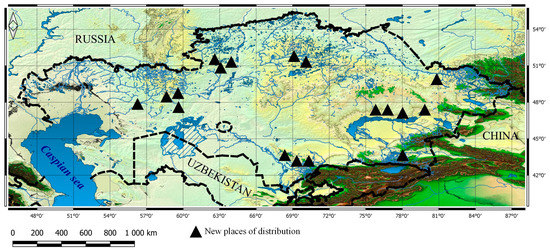
Figure 4.
Distribution of Dactylorhiza incarnata (L.) Soó in Kazakhstan.
Semipalatinsk pinery: Ribbon pine forests of Irtysh, Semipalatinsk District 1930, Shulba Forestry, pine forest near the village Mikhailovka, edge of the lake, 21.VII.1930, I.A. Winter (LE!).
Kokchetav: Kokshetau upland, Archaly river, 5 km from the village Lesogorskoye, near the river bank, meadows, 24.VI.1929, Yu.S. Grigoryev (LE!); Kokshetau upland, West Akmola Expedition 1913, Akmola Region, Kokchetav county, wet meadow, near the village Dorofeyevka, 9.VI.1913, V.P. Drobov (LE!); Akmola region, southeast of the station Shchuchya, 28.VI.1897, A. Gordiagin (LE!).
Mugodzhary: Mugodzhary mountains, northwestern part, Kyrgyz county, Sands of Urkach, in the meadow, 6.VII.1904, V. Dubinsky (LE!); Mugodzhary mountains, Temir county, Aulie river valley, along rocky shores, 19.VII.1904, V. Dubinsky (LE!); Mugodzhary mountains, Expedition to Kazakhstan, 1927, surroundings of mountain Botubai, wet meadow, 8.VI.1927, F. Rusanov (LE!); Mugodzhary mountains, the upper reaches of the Chiyli River, near the tract Dusaken-Urkach, saline meadows of the slopes, 2.VII.1927, I.M. Krasheninnikov (LE!); Mugodzhary mountains, surroundings of Ber-Chogur, raw meadow, 10.VI.1927, surroundings of mountain Ayryuk, western slope, river valley, mixed grass meadows, 3.VII.1927, I.M. Krasheninnikov (LE!); Mugodzhary mountains, The Mugodzhar.-Emba expedition under the direction of G. Dohman, at the foot of Dautau Mountain, a hollow, in a meadow, near the exit of streams, 14.VI.1934, M. Khomutova (MW!); Mugodzhary mountains, foot of Beistau mountain, swampy meadow in the valley, 23.VI.1934, N. Samsel (MW!); Degelen mountains, expedition to Karkaraly district, along the banks of the Uzun-Bulak stream, raw meadow, 29.V.1910, S.E. Kucherovskaya (LE!).
Emba: Podural plateau, Embene tour of 1908, Temir district, Kuzha-Tugay tract, 22.V.1908, D.N. Borodin, B.P. Uvarov (LE!).
Turgai: Turgai hollow, Naurzum state reserve, 20 km to east of the village Aksuat, in the thickets of Betula and Salix, in the upper reaches of the Ayan-Bulak stream, 12.VI.1936, A. Voronov (MW!); Kustanai district, between the villages of Traktovy and Nazaryevsky, on the edge of the lake basin, lake Ubalva, in the meadow, 7.VII.1913, M. Korotky, Z. Lebedeva (LE!); Expedition to Turgai district in 1909, Turgai region, Naurzum district, Ulkun-damdy river valley, moss swamp among the spring along the slopes of the stream valley, birch and willow thickets, 23.VI.1909, V.M. Savic (LE!).
East upland: Kyzylarai mountains, southern tip, north of the Begazy Mountains, floodplain of the drying Karatal River, wet meadow along the shore, 2.VII.1969, A. Mishenkova (LE!); Zhaman-Kyzylarai mountains, Karaganda region, saline meadow in the valley of the river Zhenishke, 27.VI.1959, L.V. Denisova (LE!); Chingiztau ridge, expedition to Semipalatinsk district 1914, middle part, Mukor river, upon exiting the mountain, in wet meadows, 27.V.1914, N.V. Shipchinsky (LE!); Chingiztau ridge, mount Matash, meadow in the valley, 7. VI.1914, K.K. Kosinsky (LE!); Chingiztau ridge, Barlu-Akzhailau, raw meadow, 22.VI.1914, V.V. Sapozhnikov and B. Genin (LE!); Chingiztau ridge, the foot of the southern slope of Mount Akzhuman, a hollow with a spring stream, wet meadow with Sanguisorba, 21.VI.1984, A. Korobkov (LE!); Chingiztau ridge, valley of Chagan river, 1.5 km above the mouth of the Saryzhal river, floodplain meadow, 14.VI.1984, A. Korobkov (LE!); valley of Bakanas river, near the village Ramadan, right bank, wet floodplain meadow, 9.VI.1984, A. Korobkov (LE!); the upper reaches of the Bakanas river, the headwaters of the Kyzyluzen river, along the Barmatas-Abay road, raw meadow, 11.VI.1984, V.I. Grubov (LE); valley of Namas river, raw mountain meadow, 28.V.1914, K.K. Kosinsky (LE!).
Ile Kungei Alatau: Ile Alatau, valley of the Kulsary river, near the Medeo tract, raw meadow, 1600 m above sea level, 28.VI.1936, N.V. Pavlov (MW!).
Karatau: Karatau ridge, Bayaldau tract, meadow lowering near the water at the bottom of the gorge, 19.V.1930, S.I. Lipshits (MW!); Karatau ridge, Kuyuk pass, on the banks of the stream, raw meadows, 24.V.1939, N.V. Pavlov (MW!); Karatau ridge, Kurymbel tract, wet meadow on the banks of a stream, 3.VII.1970, M.G. Pimenov (MW!); foothills of Karatau, a swamp in a gorge among the rocks behind the village Babai-Kurgan, 2.IV.1930, S.I. Lipshits (MW!).
3.2.2. Dactylorhiza salina (Turcz. ex Lindl.) Soó, Nom. Nov. Gen. Dactylorhiza: 4 (1962). ≡ Orchis salina Turcz. ex Lindl., Gen. Sp. Orchid. Pl.: 259 (1835); Kuznetsov and Pavlov, Fl. Kaz. 2: 273 (1958). ≡ Orchis orientalis subsp. salina (Turcz. ex Lindl.) Klinge, Trudy Imp. S.-Peterburgsk. Bot. Sada 17(1): 185 (1898), nom. superfl. ≡ Dactylorchis salina (Turcz. ex Lindl.) Verm., Stud. Dactylorch.: 66 (1947). ≡ Dactylorhiza cruenta subsp. salina (Turcz. ex Lindl.) E. Nelson, Monogr. and Ikonogr. Orchid.-Gattung. Serapias, Aceras, Loroglossum, Barlia: 70 (1976)
Dactylorhiza salina is a well-recognized taxon; however, this species appears to be closely related to D. incarnata s.l. and is often misidentified with the latter.
Habitat and general distribution: It grows in moist meadows, sometimes with little salinization, swamps, and on the edges of salt marshes. The distribution of this species extends from the Caucasus through Central Asia to the Amur river and sparsely as far as Siberia.
Distribution in Kazakhstan: In the flora of Kazakhstan [64,68], it has been noted in Zaysan, Altai and Western Tien Shan. According to available herbarium data, it was found in Turgai, Dzungarian Alatau, Ketmen Terskey Alatau, Kyrgyz Alatau, and Karatau for the first time (Figure 5):
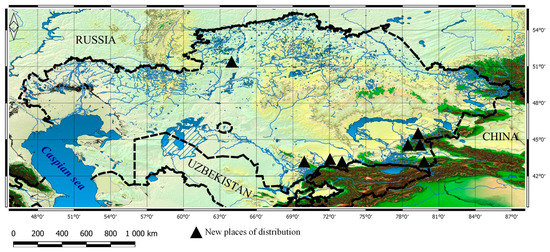
Figure 5.
Distribution of Dactylorhiza salina (Turcz. ex Lindl.) Soó in Kazakhstan.
Turgai: Turgai hollow, northern part of the Naurzum pine forest, wet meadow near the outlet of the Ugen-Blyash stream, 22.VI.1960, Gorelov (MW!).
Dzungarian Alatau: Altyn-Emel mountains, southern spurs, Tyulkum and Tyulkuli gorges, along the western slope of grass, 23.VI.1971, L. Yanchenko (LE!); Toksanbay ridge, southern slopes, the upper reaches of the Small Usek river, near the shore, 20.VI.1937, N.I. Rubtsov (AA!); Dzungarian Alatau, southern slope, the upper reaches of the Karatal river, east of the village of Karabulak, a wet peat meadow near a stream, 4.VII.1928, N.V. Shipchinsky (AA!).
Ketmen Terskey Alatau: Teskey-Ala-Too ridge, lake Tuz-Kul, meadow, 18.VII.1970, V.G. Tsagolova (AA!).
Kyrgyz Alatau: Kyrgyz ridge, western tip, Neldy river valley (southern macro slope), floodplain, 2.VI.1984, N.V. Nelina (AA!); Kenkol river valley, 4.VII.1984, N.V. Nelina (AA!); Jer-Chepkay tract, 17.IV.1876, M. Kuschakewicy (LE!).
Karatau: Karatau ridge, surroundings of the village Bir-Issek, riverbed of the Bir-Isek river, 200 m from the confluence of the Duselchik river, downstream, grass-mixed meadow, 17.V.1959, N. Parfentieva (MW!).
3.2.3. Dactylorhiza umbrosa (Kar. and Kir.) Nevski, Tr. Bot. Inst. Ac. Sci. USSR, Ser. 1,4: 332 (1937). ≡ Orchis umbrosa Kar. and Kir., Bull. Soc. Imp. Naturalistes Moscou 15: 504 (1842); Kuznetsov and Pavlov, Fl. Kaz. 2: 272 (1958). ≡ Dactylorchis umbrosa (Kar. and Kir.) Wendelbo, Nytt Mag. Bot. 1: 24 (1952)
- = Orchis orientalis subsp. turcestanica Klinge, Trudy Imp. S.-Peterburgsk. Bot. Sada 17(1): 183 (1898). ≡ Orchis turkestanica (Klinge) Klinge ex B.Fedtsch., Russk. Bot. Zhurn. 1908: 191 (1908). ≡ Dactylorhiza incarnata subsp. turcestanica (Klinge) H. Sund., Europ. Medit. Orchid., ed. 3: 40 (1980).
Dactylorhiza umbrosa is sometimes synonymized within D. incarnata subsp. cilicica (Klinge) H.Sund. However, its taxonomic status remains unclear and, in many floras of the region, it is accepted as a separate taxon; so we follow such a concept. Nevertheless, this is another species morphologically like D. incarnata and can be easily misidentified with it.
Habitat and general distribution: It grows along river banks, swamps, often in highland communities, and in the subalpine zone.
Distribution area: Iran, Afghanistan, Pakistan, Central Asia, South Siberia, Dzungaria, India, Northwest China, and Mongolia.
Distribution in Kazakhstan: In the flora of Kazakhstan [64,68,70,77], it has been noted in Tobol-Ishim, Turgai, Altai, Tarbagatai, Dzungarian Alatau, Ile Kungei Alatau, Ketmen Terskey Alatau, Kyrgyz Alatau, Karatau, and Western Tien Shan. According to available herbarium data, it was first found in: Semipalatinsk pinery, Kokchetav, Mugodzhary, Western upland, East upland, and Zaysan (Figure 6):
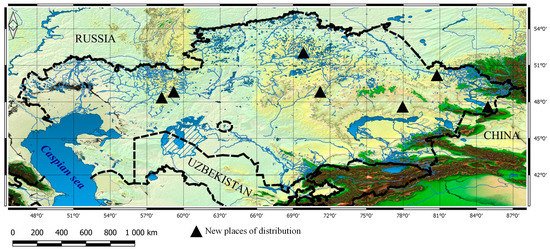
Figure 6.
Distribution of Dactylorhiza umbrosa (Kar. and Kir.) Nevski in Kazakhstan.
Semipalatinsk pinery: Ribbon pine forests of Irtysh, Semipalatinsk district, between the villages of Dymovsky and Baturinsky, meadow, 14.VI.1928, M.M. Ilyin (AA!).
Kokchetav: Kokshetau upland, Borovoe tract, damp salt marsh meadow near the Karabulak stream, near cordon Mirny, valley, 25.VI.1937, L. Sobolev (AA!);
Mugodzhary: Mugodzhary mountains, Aktobe region, surroundings of Ber-Chugur, a ravine on the northern slope of mount Bohtubay, 10.VI.1927, F.N. Rusanov (AA!); to the north-west from Ber-Chugur station on the road to Mugodzharsk, moist, slightly saline meadows, on the bottom of the hollow, 25.VI.1927, I.M. Krasheninnikov (AA!);
Western upland: Western upland, basin of Sarysu River, the origins of the river Sirt-Su, Kara-Agach tract, along a moist meadow near an aspen forest, 13.VI.1949, V.P. Goloskokov (AA!).
East upland: Chingiztau ridge, upper reaches of the Kalguty river, swamp at a willow-birch forest in the valley, 17.VI.1958, A.P. Gamayunova (AA!).
Zaysan: Chilicty valley, meadow along the Kandy-Su river, 17.VI.1900, V. Reznichenko (LE!); to the left of the Arda river valley, meadows to the east, 7.VI.1903, V. Reznichenko (LE!).
3.2.4. Dactylorhiza magna (Czerniak.) Iconn., Nov. Syst. Visch. Rast. 9:303 (1972). ≡ Orchis magna Czerniak., Fl. Uzbekistan. 1: 546 (1941); Kuznetsov and Pavlov, Fl. Kaz. 2: 272 (1958). ≡ Dactylorhiza umbrosa subsp. magna (Czerniak.) Soó, Ann. Univ. Sci. Budapest. Rolando Eötvös, Sect. Biol. 11: 68 (1969)
- = Dactylorhiza baldshuanica Cherniak., Bot. Zhurn. (Moscow and Leningrad) 68: 534 (1983).
A rather well-recognized taxon, with a rather local character in distribution, as for the genus Dactylorhiza. In many respects, it requires better understanding.
Habitat and general distribution: It grows in the valleys of mountain rivers, as well as at the mouths and headwaters, and on the haloxerophilic shores of lakes [76]. Species native to the Central Asia, mainly Kirgizstan, Tadzhikistan, and Uzbekistan.
Distribution in Kazakhstan: In the flora of Kazakhstan [64,70,71] it has been noted in Kyrgyz Alatau and Western Tien Shan. According to available herbarium data, it was first found in Karatau (Figure 7):
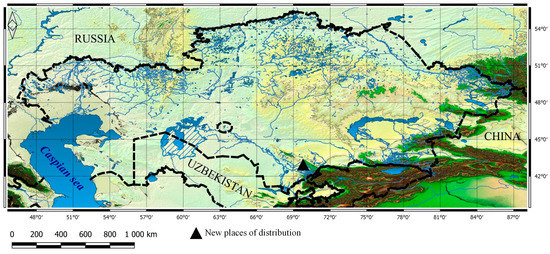
Figure 7.
Distribution of Dactylorhiza magna (Czerniak.) Iconn. in Kazakhstan.
Karatau: Berkara gorge, 15.VIII.1946, N.V. Pavlov (AA!).
3.2.5. Dactylorhiza majalis subsp. baltica (Klinge) H.Sund., Europ. Medit. Orchid., ed. 3: 40 (1980). ≡ Orchis latifolia subsp. baltica Klinge, Trudy Imp. S.-Peterburgsk. Bot. Sada 17(1): 153, 170 (1898); Kuznetsov and Pavlov, Fl. Kaz.2: 271 (1958). ≡ Orchis latifolia f. baltica (Klinge) M.Schulze, Mitth. Thüring. Bot. Vereins, n.f., 17: 51 (1902). ≡ Orchis baltica (Klinge) A.Fuchs, Ber. Naturwiss. Vereins Schwaben Neuburg 42: 42 (1919). ≡ Dactylorchis baltica (Klinge) Verm., Stud. Dactylorch.: 67 (1947). ≡ Dactylorhiza latifolia subsp. baltica (Klinge) Soó, Nom. Nov. Gen. Dactylorhiza: 5 (1962). ≡ Dactylorhiza baltica (Klinge) N.I. Orlova, Konsp. Fl. Pskov. Obl., Leningrad: 57 (1970)
- = Orchis longifolia Neuman, Bot. Not. 1909: 241 (1909). ≡ Dactylorchis longifolia (Neuman) Verm., Stud. Dactylorch.: 67 (1947). ≡ Dactylorhiza latifolia var. longifolia (Neuman) Soó, Nom. Nov. Gen. Dactylorhiza: 5 (1962). ≡ Dactylorhiza longifolia (Neuman) Aver., Bot. Zhurn. (Moscow and Leningrad) 69: 875 (1984).
This taxon has been originally described as being from Central Europe, from the southern coast of Baltic. Its character, as a distinct taxon, has been confirmed, and is occasionally treated as a separate species. However, like many taxa within the D. majalis s.l. group, it is quite difficult to identify.
Habitat and general distribution: It grows in moist meadows and at forest edges; on mountain slopes it can rise up to 1700 m.a.s.l. The taxon occurs from Central and Northern Europe to Northern Central Asia, mainly in the Siberia region.
Distribution in Kazakhstan: In the flora of Kazakhstan [64], it has been noted in Altai. According to available herbarium data, it was first found in Ile Kungei Alatau (Figure 8):
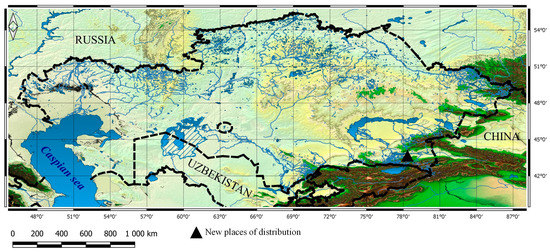
Figure 8.
Distribution of Dactylorhiza majalis subsp. baltica (Klinge) H.Sund. in Kazakhstan.
Ile Kungei Alatau: Kungei Ala-Too, Zhalanashsai gorge, 11.VII.1996, S.K. Mukhtubaeva (AA!)
3.3. Ecological Niche Modeling
3.3.1. ENM Analysis Evaluation and Bioclimatic Variables Contribution
The AUC for the created models received high values of 0.938–0.984, with a standard deviation of 0.004–0.016 (Table 2). Referring to the relative contributions of the bioclimatic variables of the ENM, we can distinguish two groups of taxa (Table 3). The first are mainly European with a dominance of Bio14 contribution (51.4–54.1%) and taxa such as D. incarnata and D. majalis subsp. baltica. The second are Asian species, D. salina and D. umbrosa, and a modestly dominant Bio2 (22.9–30.5%).

Table 2.
The average training AUC for the replicate runs and the standard deviation (in bracket) obtained for models for studied taxa.

Table 3.
Relative contributions of the bioclimatic variables in the Maxent model (top three values), normalized to percentage (in bracket).
3.3.2. Current Distribution and the Ecological Niche Models for Taxa
The present distribution in the resulting models is consistent with the occurrence data collected in our studies (Figure 9). Although, the obtained models for mainly European taxa indicate relatively small areas or low suitability for their occurrence in Kazakhstan. What is confirmed in the few sites of these species is that only D. incarnata is abundantly recorded in the country. Interestingly, the obtained models do not indicate such extensive occurrence.
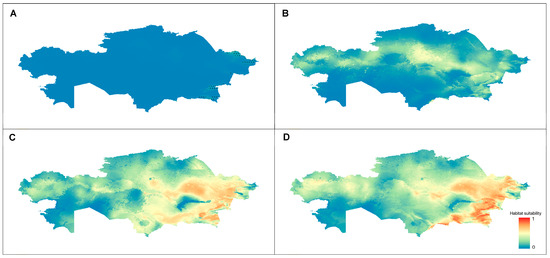
Figure 9.
Present habitat suitability in Kazakhstan for Dactylorhiza majalis subsp. baltica (Klinge) H.Sund. (A), D. incarnata (L.) Soó (B), D. salina (Turcz. ex Lindl.) Soó (C), and D. umbrosa (Kar. and Kir.) Nevski (D). For D. majalis subsp. baltica, black dots additionally show areas above 0.5 threshold from the grid with the maximum potential distribution.
The taxon with the most restricted occurrence in Kazakhstan is D. majalis subsp. Baltica, with few areas in the eastern part of the country and floristic areas associated with the Altai Mountains (Figure 9A). For another taxon, D. incarnata, the models obtained indicate areas extending from the east through the central and western parts of the country that are associated with upland areas (Figure 9B). Again, however, the suitability of these areas is at a medium to low level.
Completely different models with ENM analysis were obtained for typically Asian species, D. salina and D. umbrosa. They indicate significant areas of high and very high suitability in a very large part of the country. However, with the dominance of the areas of the Altai Mountains, Thien Shan, and Kazakh Uplands (Figure 9C,D)
3.3.3. Future Changes in the Distribution
The models obtained in the ENM analysis for all studied taxa and the four climate change scenarios for the future do not show significant differences in distribution in the context of the areas indicated in the models for the present (Figures S6–S9).
In the case of predominantly European taxa, most of Kazakhstan is still potentially unsuitable for their occurrence and, at a threshold of 0.5, areas of no occurrence reach 98.28–99.87% (Table 4, Figure 10 and Figure 11). On the other hand, for typically Asian species D. salina and D. umbrosa, no occurrence areas remain stable, reaching 80.01–80.83% (Table 4, Figure 12 and Figure 13).

Table 4.
Comparison of the results of potential changes in the area of occurrence (threshold 0.5) for the four future climate change scenarios versus the models for the present (in km2) along with the percentage of this change. The percentage of change is expressed in relation to the area of occurrence for the present, and for the no occupancy in relation to the total area of the country.
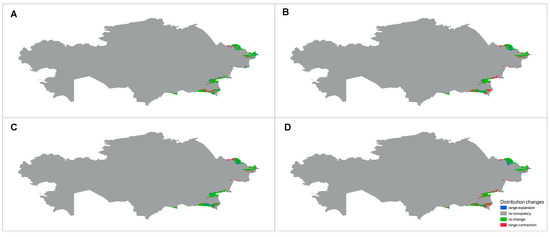
Figure 10.
Changes in the distribution of suitable habitats in Kazakhstan for Dactylorhiza majalis subsp. baltica (Klinge) H.Sund. and four climate change scenarios—spp126 (A), spp245 (B), spp370 (C), and spp585 (D).
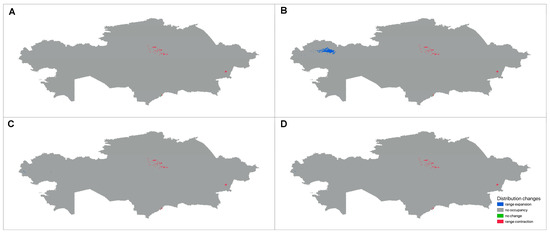
Figure 11.
Changes in the distribution of suitable habitats in Kazakhstan for Dactylorhiza incarnata (L.) Soó. and four climate change scenarios—spp126 (A), spp245 (B), spp370 (C), and spp585 (D).

Figure 12.
Changes in the distribution of suitable habitats in Kazakhstan for D. salina (Turcz. ex Lindl.) Soó. and four climate change scenarios—spp126 (A), spp245 (B), spp370 (C), and spp585 (D).
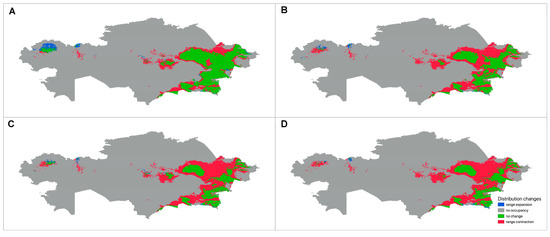
Figure 13.
Changes in the distribution of suitable habitats in Kazakhstan for D. umbrosa (Kar. and Kir.) Nevski. and four climate change scenarios—spp126 (A), spp245 (B), spp370 (C), and spp585 (D).
Dactylorhiza majalis subsp. baltica, under all future scenarios, has relatively stable areas of no change reaching 69.27–82.15%. Two scenarios, spp245 and spp585, are the most damaging for this subspecies and the range expansion reach 30.73% and 28.19%, respectively. On the other hand, the models indicate the possibility of range expansion, even under scenarios indicating the most significant climate change, and are usually in the range 7.50–11.56% (Table 4, Figure 10). It should be noted, however, that D. majalis subsp. baltica is still the taxon with the lowest areas suitable for its occurrence, as indicated by the ENM analyses. Due to the lack of areas above the 0.5 threshold in all grids obtained, apart from those indicating the maximum possible areas, this one was used in the analysis comparing future scenarios.
The next taxon, D. incarnata, shows a similar pattern of responses in the future. The ENM analyses only show a few areas of suitable habitat above 0.5 and, for both, all scenarios show areas of disappearance, reaching almost 100% (Table 4, Figure 11). Interestingly, some scenarios show the possibility of increasing range, and significantly more so in the models for the present. In the case of D. incarnata, in scenario spp245, the range of expansion reaches 265.38% (Table 4, Figure 11). However, under a worst-case climate change scenario, spp585, ENM analyses in Kazakhstan indicate a lack of suitable sites for these taxa.
Finally, for typically Asian species, D. salina and D. umbrosa, ENM analyses for all future scenarios indicate a significant loss of suitable areas. The most damaging scenario is spp585, which shows the most significant global warming, where the range of contraction reaches 81.89% and 68.37%. (Table 4, Figure 12 and Figure 13). Furthermore, the range of expansion in both cases are very few and reach 0.74–4.58%. Therefore, it is likely that the occurrence of these species in Kazakhstan will begin to significantly decrease.
4. Discussion
Floristic and taxonomic studies have revealed taxa new to the national flora or particular floristic regions in Kazakhstan. This is another confirmation that the herbarium materials deposited in collections have evidential functions and can provide a range of new data [83,84,85]. In addition, basic botanical research continues to fill the knowledge gaps in the natural sciences [85,86]. On the other hand, genera such as Dactylorhiza are challenging to correctly determine [6,7,12], and misidentification can result in a region’s biodiversity being misestimated [87,88]. For this reason, the undertaking of basic taxonomic studies and understanding the boundaries of taxa is still a very important research field.
Taxa new to Kazakhstan are D. fuchsii subsp. hebridensis and D. × kerneri. The first is a subspecies whose taxonomic status remains uncertain, but is often accepted and reported in the literature of the North Asian region [63,89,90]. However, there have been no studies indicating how much this conception of the taxon coincides with its original description. Dactylorhiza is known for its very high morphological variability, so some taxonomic concepts are difficult to apply in practice only based on morphology. The second finding is a nothospecies, a hybrid, which between taxa in the genus Dactylorhiza frequently happens. It is hypothesized that many species within the genus may have evolved this way [12,15,17,91]. Therefore, species diversity versus genetic diversity within a genus can be completely different and continues to be a challenge for taxonomists.
Taxa new to specific regions of Kazakhstan are a confirmation that many places are still not fully inventoried. Those that are less populated and large in area, often with a well-preserved nature and potentially valuable, are worthy of more detailed study [20,21,22]. Three species, D. incarnata, D. salina, and D. umbrosa, are common in the region, but two taxa, D. magna and D. majalis subsp. Baltica, are rare in the national flora. Dactylorhiza magna is more common in Central Asia; therefore, its occurrence in Kazakhstan is probably its northern limit of its distribution range. On the other hand, the situation with D. majalis subsp. baltica is completely different, and its occurrence in Kazakhstan is its southern limit of its range of distribution, as the taxon is mainly recorded in Northern Europe and the Siberia region [63,92,93].
Dactylorhiza species are usually associated with open areas, often meadows, and are characterized by high soil moisture, like marshes, swamps, bogs, banks of rivers, and shores of lakes [63]. Unfortunately, such habitats are often sensitive and vulnerable to harmful changes, such as those associated with the disruption of water conditions. A very significant threat today is global warming [94,95].
The conducted ENM analyses indicate that the occurrence of Dactylorhiza representatives in Kazakhstan will be significantly disturbed by global climate warming. It is possible that some taxa will not occur in Kazakhstan in the future, and this applies to D. incarnata, and D. majalis subsp. baltica. The range of another two, D. salina and D. umbrosa, will be significantly reduced.
Models from ENM analyses of the four taxa with mainly European distributions show that most areas in Kazakhstan have relatively low suitability. Perhaps it would be appropriate to consider whether they are relics in the country. Studies on glacial refugia during the maximum of the last glaciation [96], based on ENM analysis and for selected species from the groups of D. incranata/maculata and D. majalis, have also indicated areas in southeastern Asia in addition to southern Europe. During migration after the glaciation, the taxa may have reached Kazakhstan, but today, they are in decline. However, more research is needed to confirm this hypothesis. In the case of the two typically Asian species, their range in Kazakhstan is wide, but climate change may significantly reduce their occurrence and make it far more disjunctive. Pfeifer et al. [97,98], studying another species of orchid in Europe, revealed that historical changes, mainly post-glacial, are important for the genetic structure of a population. Disjunctive distribution and response to climate change can also play a significant role in shaping it, which is important in planning species conservation efforts. There is a lack of global genetic studies on Dactylorhiza; however, from larger or smaller scale studies, it is known that the genetic variation in Dactylorhiza representatives is not relatively high [8,11,12].
The study presented here used bioclimatic data, but it is important to remember that orchids are often specialists and many other factors are important in their occurrence. Furthermore, the ability to shift their range in response to climate change, as observed for other plants [27,28], is severely limited [21]. This places many orchid taxa at high risk of global climate change [25,32,96,99]. In the case of Dactylorhiza, these are mainly taxa associated with swampy habitats, which in Kazakhstan are under strong pressure both from overall progressive desertification and human activities, i.e., unsustainable irrigation or overgrazing of animals in such areas [29].
Finally, when analyzing the network of protected areas in Kazakhstan (Figure 14), many of them do not include areas potentially important for future conservation. In many of the models obtained, areas in the southeast of the country, in the Tien Shan mountains, have been indicated as important for the occurrence of the studied taxa and will be important for the preservation of populations of D. salina and D. umbrosa. The same is valid for the Altai mountain area in the northeast, which is fortunately protected. Another area is the west uplands, which in some models are indicated as areas where the studied taxa will expand their range. On the other hand, there are uplands in the east that have been indicated as important locations for D. salina and D. umbrosa, which are resistant to climate change.
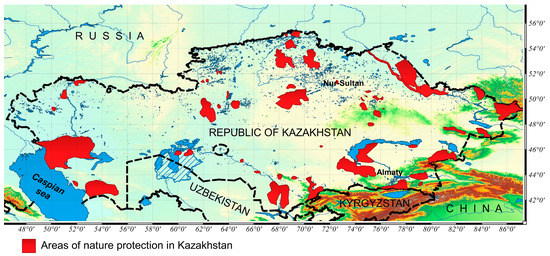
Figure 14.
Map of protected areas in Kazakhstan.
5. Conclusions
Revision and analysis of herbarium materials revealed new taxa for the flora of Kazakhstan: D. fuchsii subsp. hebridensis (Wilmott) Soó and D. × kerneri (Soó) Soó, as well as new species for certain botanical and geographical areas of Kazakhstan. D. incarnata (L.) Soó was first identified for Semipalatinsk pinery, Kokchetav, Mugodzhary, Emba, Turgai, East upland, Ile Kungei Alatau, Karatau; D. salina (Turcz. Ex Lindl.) Soó for Turgai, Dzungarian Alatau, Ketmen Terskey Alatau, Kyrgyz Alatau, Karatau; D. umbrosa (Kar. Et Kir.) Nevski for Semipalatinsk pinery, Kokchetav, Mugodzhary, Western upland, East upland, Zaysan; D. magna (Czerniak.) Iconn. for Karatau; D. majalis subsp. baltica (Klinge) H.Sund. for Ile Kungei Alatau. Due to the taxonomic complexity of the genus, the status of some Dactylorhiza representatives requires further studies. Some of the taxa probably reach the limits of their range of occurrence in Kazakhstan; southern for D. majalis subsp. baltica and northern for D. magna.
The occurrence of Dactylorhiza representatives in Kazakhstan is threatened by global climate warming. Species with a mainly European and northern Asia distribution are relatively uncommon. It is likely that some of them may not occur in the country in the future (D. incarnata, and D. majalis subsp. baltica). Species mainly found in Central Asia with potential for future occurrence in the country, significantly reduce their range (D. salina and D. umbrosa). It is worth considering global changes in planning conservation activities and identifying areas that may play a significant role in the functioning of the national flora in the future.
Supplementary Materials
The following supporting information can be downloaded at: https://www.mdpi.com/article/10.3390/d15030369/s1, Figure S1: Present habitat suitability for Dactylorhiza majalis subsp. baltica (Klinge) H.Sund. (A), D. incarnata (L.) Soó (B), D. salina (Turcz. ex Lindl.) Soó (C), and D. umbrosa (Kar. and Kir.) Nevski (D); Figure S2: Future habitat suitability for Dactylorhiza majalis subsp. baltica (Klinge) H.Sund. and four climate change scenarios—spp126 (A), spp245 (B), spp370 (C), and spp585 (D); Figure S3: Future habitat suitability for Dactylorhiza incarnata (L.) Soó and four climate change scenarios—spp126 (A), spp245 (B), spp370 (C), and spp585 (D); Figure S4: Future habitat suitability for Dactylorhiza salina (Turcz. ex Lindl.) Soó and four climate change scenarios—spp126 (A), spp245 (B), spp370 (C), and spp585 (D); Figure S5: Future habitat suitability for Dactylorhiza umbrosa (Kar. and Kir.) Nevski. and four climate change scenarios—spp126 (A), spp245 (B), spp370 (C), and spp585 (D); Figure S6: Future habitat suitability in Kazakhstan for Dactylorhiza majalis subsp. baltica (Klinge) H.Sund. and four climate change scenarios—spp126 (A), spp245 (B), spp370 (C), and spp585 (D); Figure S7: Future habitat suitability in Kazakhstan for Dactylorhiza incarnata (L.) Soó and four climate change scenarios—spp126 (A), spp245 (B), spp370 (C), and spp585 (D); Figure S8: Future habitat suitability in Kazakhstan for Dactylorhiza salina (Turcz. ex Lindl.) Soó and four climate change scenarios—spp126 (A), spp245 (B), spp370 (C), and spp585 (D); Figure S9: Future habitat suitability in Kazakhstan for Dactylorhiza umbrosa (Kar. and Kir.) Nevski. and four climate change scenarios—spp126 (A), spp245 (B), spp370 (C), and spp585 (D); Table S1: List of localities from Kazakhstan used in the ecological niche modeling; Table S2: List of GBIF Occurrence Download used in the study.
Author Contributions
Conceptualization, A.A.S. and S.N.; methodology, A.A.S. and S.N.; software, S.N.; validation, A.A.S., D.L.S. and S.N.; formal analysis, A.K.-C. and S.N.; investigation, A.A.S. and S.N.; resources, A.A.S. and S.N.; data curation, A.A.S., A.B.-H., A.K.-C. and S.N.; writing—original draft preparation, A.A.S., A.B.-H. and A.K.-C.; writing—review and editing, D.L.S., A.K.-C. and S.N.; visualization, A.A.S. and S.N.; supervision, D.L.S.; project administration, A.A.S. and S.N.; funding acquisition, A.A.S. All authors have read and agreed to the published version of the manuscript.
Funding
This article was prepared as part of the project AR05133868 “Study of the distribution and current status of populations of the Orchidaceae family in Kazakhstan Altai and their introduction in the Altai Botanical Garden”.
Data Availability Statement
The data presented in this study are available in Supplementary Materials or on request from the corresponding author. Publicly available datasets were analyzed in this study. This data can be found in Table S2.
Acknowledgments
The authors are sincerely grateful to the heads and curators of Herbaria: G.M. Kudabaeva, P.V. Veselova (AA), V.I. Dorofeev (LE), A.P. Seregin (MW), as well as A.N. Kupriyanov for valuable guidance and comments. We thank the anonymous reviewers for all their valuable comments on the first version of the manuscript.
Conflicts of Interest
The authors declare no conflict of interest.
References
- Necker, N.J. Elementa Botanica 3, Neowedae ad Rhenum; Societatis Typographicae Neowedensis: Paris, Frane, 1790. [Google Scholar]
- Nevski, S.A. Materials for the flora of the Kugitang Mountains and its foothills. Tr. Bot. Inst. Akad. Nauk. SSSR Seriya 1 Flora I Sist. Vyss. Rastenii 1937, 4, 199–346. [Google Scholar]
- Nevski, S.A. Fam. 36, The Orchids-Orchidaceae Lindl; Komarov, V.L., Ed.; Publishers of Academy of Sciences: Cambridge, MA, USA, 1935; pp. 589–730. [Google Scholar]
- Taraška, V.; Batoušek, P.; Duchoslav, M.; Temsch, E.M.; Weiss-Schneeweiss, H.; Trávníček, B. Morphological variability, cytotype diversity, and cytogeography of populations traditionally called Dactylorhiza fuchsii in Central Europe. Plant Syst. Evol. 2021, 307, 1–21. [Google Scholar] [CrossRef]
- D’Emerico, S.; Cozzolino, S.; Pellegrino, G.; Pignone, D.; Scrugli, A. Karyotype structure, supernumerary chromosomes and heterochromatin distribution suggest a pathway of karyotype evolution in Dactylorhiza (Orchidaceae). Bot. J. Linn. Soc. 2002, 138, 85–91. [Google Scholar] [CrossRef]
- Averyanov, L. A Review of the Genus Dactylorhiza. In Orchid Biology—Reviews and Perspectives; Arditti, J., Ed.; V. Timber Press Inc.: Portland, OR, USA, 1990; pp. 159–206. [Google Scholar]
- Pedersen, H. Species concept and guidelines for infraspecific taxonomic ranking in Dactylorhiza (Orchidaceae). Nord. J. Bot. 1998, 18, 289–310. [Google Scholar] [CrossRef]
- Pillon, Y.; Fay, M.F.; Hedrén, M.; Bateman, R.M.; Devey, D.S.; Shipunov, A.B.; van der Bank, M.; Chase, M.W. Evolution and temporal diversification of western European polyploid species complexes in Dactylorhiza (Orchidaceae). Taxon 2007, 56, 1185–1208. [Google Scholar] [CrossRef]
- Brandrud, M.K.; Baar, J.; Lorenzo, M.T.; Athanasiadis, A.; Bateman, R.M.; Chase, M.W.; Hedrén, M.; Paun, O. Phylogenomic Relationships of Diploids and the Origins of Allotetraploids in Dactylorhiza (Orchidaceae). Syst. Biol. 2020, 69, 91–109. [Google Scholar] [CrossRef]
- Tropicos.org. Missouri Botanical Garden. Available online: https://tropicos.org (accessed on 4 May 2021).
- IPNI—The International Plant Names Index. Available online: http://www.ipni.org (accessed on 4 May 2021).
- Pillon, Y.; Fay, M.F.; Shipunov, A.B.; Chase, M.W. Species diversity versus phylogenetic diversity: A practical study in the tax-onomically difficult genus Dactylorhiza (Orchidaceae). Biol. Conserv. 2006, 4, 129. [Google Scholar] [CrossRef]
- Hedrén, M.; Birkedal, S.; de Boer, H.; Ghorbani, A.; Gravendeel, B.; Hansson, S.; Svensson, Å.; Zarre, S. Asymmetric contributions of seed and pollen to gene dispersal in the marsh orchid Dactylorhiza umbrosa in Asia Minor. Mol. Ecol. 2021, 30, 1791–1805. [Google Scholar] [CrossRef] [PubMed]
- Devos, N.; Raspe, O.; Jacquemart, A.L.; Tyteca, D. On the monophyly of Dactylorhiza Necker ex Nevski (Orchidaceae): Is Coelo-glossum viride (L.) Hartman a Dactylorhiza? Bot. J. Linn. Soc. 2006, 152, 261–269. [Google Scholar] [CrossRef]
- Shipunov, A.B.; Fay, M.F.; Pillon, Y.; Bateman, R.M.; Chase, M.W. Dactylorhiza (Orchidaceae) in European Russia: Combined molecular and morphological analysis. Am. J. Bot. 2004, 91, 1419–1426. [Google Scholar] [CrossRef]
- Shipunov, A.B.; Bateman, R.M. Geometric morphometrics as a tool for understanding Dactylorhiza (Orchidaceae) diversity in European Russia. Biol. J. Linn. Soc. 2005, 85, 1–12. [Google Scholar] [CrossRef]
- Hedrén, M.; Fay, M.F.; Chase, M.W. Amplified fragment length polymorphisms (AFLP) reveal details of polyploid evolution in Dactylorhiza (Orchidaceae). Am. J. Bot. 2001, 88, 1868–1880. [Google Scholar] [CrossRef]
- Abdulina, S.A. Spisok Sosudistyh Rastenij Kazahstana; Kamelina, R.V., Ed.; Academy of Sciences of the Republic of Kazakhstan: Almaty, Kazakhstan, 1998; p. 187. [Google Scholar]
- The Red Book of Kazakhstan; Astana LTD: Astana, Kazakhstan, 2014; Volume 2, p. 452.
- Akzhigitova, N.I.; Brekle, Z.V.; Volkova, E.A.; Vinkler, G.; Vukhrer, V.; Ogar, Y.Y.; Rachkovskaya, Y.I.; Safronova, I.N.; Khramstov, V.N.; Makulbekova, G.B.; et al. Botanicheskaya Geografiya Kazakhstana i Srednei Azii (v Predelakh Pustynnoi Oblasti); Boston-Spectrum: St. Petersburg, Russia, 2003. [Google Scholar]
- Kamp, J.; Koshkin, M.A.; Bragina, T.M.; Katzner, T.E.; Milner-Gulland, E.J.; Schreiber, D.; Sheldon, R.; Shmalenko, A.; Smelansky, I.; Terraube, J.; et al. Persistent and novel threats to the biodiversity of Kazakhstan’s steppes and semi-deserts. Biodivers. Conserv. 2016, 25, 2521–2541. [Google Scholar] [CrossRef]
- Hu, Y.; Han, Y.; Zhang, Y. Land desertification and its influencing factors in Kazakhstan. J. Arid. Environ. 2020, 180, 104203. [Google Scholar] [CrossRef]
- UNECE. Environmental Performance Review; United Nations: Geneva, Switzerland, 2019. [Google Scholar]
- BIFOR. Biodiversity Assessment for Kazakhstan; Chemonics International INC.: Washington, DC, USA, 2001. [Google Scholar]
- Wani, I.; Kumar, V.; Verma, S.; Jan, A.T.; Rather, I. Dactylorhiza hatagirea (D. Don) Soo: A Critically Endangered Perennial Orchid from the North-West Himalayas. Plants 2020, 9, 1644. [Google Scholar] [CrossRef] [PubMed]
- Kelly, A.E.; Goulden, M.L. Rapid shifts in plant distribution with recent climate change. Proc. Natl. Acad. Sci. USA 2008, 105, 11823–11826. [Google Scholar] [CrossRef]
- Dainese, M.; Aikio, S.; Hulme, P.E.; Bertolli, A.; Prosser, F.; Marini, L. Human disturbance and upward expansion of plants in a warming climate. Nat. Clim. Chang. 2017, 7, 577–580. [Google Scholar] [CrossRef]
- Lamprecht, A.; Semenchuk, P.R.; Steinbauer, K.; Winkler, M.; Pauli, H. Climate change leads to accelerated transformation of high-elevation vegetation in the central Alps. New Phytol. 2018, 220, 447–459. [Google Scholar] [CrossRef]
- Geppert, C.; Perazza, G.; Wilson, R.J.; Bertolli, A.; Prosser, F.; Melchiori, G.; Marini, L. Consistent population declines but idi-osyncratic range shifts in Alpine orchids under global change. Nat. Commun. 2020, 11, 5835. [Google Scholar] [CrossRef]
- Kolanowska, M.; Rewicz, A.; Baranow, P. Ecological niche modeling of the pantropical orchid Polystachya concreta (Orchidaceae) and its response to climate change. Sci. Rep. 2020, 10, 1–17. [Google Scholar] [CrossRef]
- Kolanowska, M.; Jakubska-Busse, A. Is the lady’s-slipper orchid (Cypripedium calceolus) likely to shortly become extinct in Europe?—Insights based on ecological niche modelling. PLoS ONE 2020, 15, e0228420. [Google Scholar] [CrossRef]
- Shrestha, B.; Tsiftsis, S.; Chapagain, D.J.; Khadka, C.; Bhattarai, P.; Kayastha Shrestha, N.; Kolanowska, M.; Kindlmann, P. Suitability of Habitats in Nepal for Dactylorhiza hatagirea Now and under Predicted Future Changes in Cli-mate. Plants 2021, 10, 467. [Google Scholar] [CrossRef] [PubMed]
- Kolanowska, M.; Rewicz, A.; Nowak, S. Significant habitat loss of the black vanilla orchid (Nigritella nigra s.l., Orchidaceae) and shifts in its pollinators availability as results of global warming. Glob. Ecol. Conserv. 2021, 27, e01560. [Google Scholar] [CrossRef]
- Kolanowska, M.; Kras, M.; Lipińska, M.; Mystkowska, K.; Szlachetko, D.L.; Naczk, A.M. Global warming not so harmful for all plants—response of holomycotrophic orchid species for the future climate change. Sci. Rep. 2017, 7, 1–13. [Google Scholar] [CrossRef] [PubMed]
- Konowalik, K.; Kolanowska, M. Climatic niche shift and possible future spread of the invasive South African Orchid Disa bracteata in Australia and adjacent areas. PeerJ 2018, 6, e6107. [Google Scholar] [CrossRef]
- Thiers, B. Continuously Updated Index Herbariorum: A Global Directory of Public Herbaria and Associated Staff. New York Botanical Garden’s Virtual Herbarium. Available online: http://sweetgum.nybg.org/science/ih/ (accessed on 28 December 2021).
- Seregin, A.P. (Ed.) Moscow Digital Herbarium: Electronic Resource; Moscow State University: Moscow, Russia, 2020; Available online: https://plant.depo.msu.ru/ (accessed on 10 January 2020).
- Pavlov, N.V. Flora of Kazakhstan; Academy of Sciences of the Kazakh SSR: Alma-Ata, Kazakhstan, 1956; Volume 1, p. 353. [Google Scholar]
- Phillips, S.J.; Anderson, R.P.; Schapire, R.E. Maximum entropy modeling of species geographic distributions. Ecol. Model. 2006, 190, 231–259. [Google Scholar] [CrossRef]
- Elith, J.; Phillips, S.J.; Hastie, T.; Dudík, M.; Chee, Y.E.; Yates, C.J. A statistical explanation of MaxEnt for ecologists. Divers. Distrib. 2011, 17, 43–57. [Google Scholar] [CrossRef]
- Hijmans, R.J.; Cameron, S.E.; Parra, J.L.; Jones, P.G.; Jarvis, A. Very high resolution interpolated climate surfaces for global land areas. Int. J. Climatol. 2005, 25, 1965–1978. [Google Scholar] [CrossRef]
- Booth, T.H.; Nix, H.A.; Busby, J.R.; Hutchinson, M.F. BIOCLIM: The first species distribution modelling package, its early ap-plications and relevance to most current MAXENT studies. Divers. Distrib. 2014, 20, 1–9. [Google Scholar] [CrossRef]
- Barve, N.; Barve, V.; Jiménez-Valverde, A.; Lira-Noriega, A.; Maher, S.P.; Townsend Peterson, A.; Soberon, J.; Villalobos, F. The crucial role of the accessible area in ecological niche modeling and species distribution modeling. Ecol. Model. 2011, 222, 1810–1819. [Google Scholar] [CrossRef]
- Voldoire, A.; Saint-Martin, D.; Sénési, S.; Decharme, B.; Alias, A.; Chevallier, M.; Colin, J.; Guérémy, J.-F.; Michou, M.; Moine, M.-P.; et al. Evaluation of CMIP6 DECK experiments with CNRM-CM6-1. J. Adv. Mod. Earth Syst. 2019, 11, 2177–2213. [Google Scholar] [CrossRef]
- Eyring, V.; Bony, S.; Meehl, G.A.; Senior, C.A.; Stevens, B.; Stouffer, R.J.; Taylor, K.E. Overview of the Coupled Model Inter-comparison Project Phase 6 (CMIP6) experimental design and organization. Geosci. Model Dev. 2016, 9, 1937–1958. [Google Scholar] [CrossRef]
- Meinshausen, M.; Nicholls, Z.R.J.; Lewis, J.; Gidden, M.J.; Vogel, E.; Freund, M.; Beyerle, U.; Gessner, C.; Nauels, A.; Bauer, N.; et al. The shared socio-economic pathway (SSP) greenhouse gas concentrations and their extensions to 2500. Geosci. Model Dev. 2020, 13, 3571–3605. [Google Scholar] [CrossRef]
- Petrie, R.; Denvil, S.; Ames, S.; Levavasseur, G.; Fiore, S.; Allen, C.; Antonio, F.; Berger, K.; Bretonnière, P.-A.; Cinquini, L.; et al. Coordinating an operational data distribution network for CMIP6 data. Geosci. Model Dev. 2021, 14, 629–644. [Google Scholar] [CrossRef]
- Riahi, K.; Van Vuuren, D.P.; Kriegler, E.; Edmonds, J.; O’Neill, B.C.; Fujimori, S.; Bauer, N.; Calvin, K.; Dellink, R.; Fricko, O.; et al. The Shared Socioeconomic Pathways and their energy, land use, and greenhouse gas emissions implications: An overview. Glob. Environ. Chang. 2017, 42, 153–168. [Google Scholar] [CrossRef]
- Rogelj, J.; Popp, A.; Calvin, K.V.; Luderer, G.; Emmerling, J.; Gernaat, D.; Fujimori, S.; Strefler, J.; Hasegawa, T.; Marangoni, G.; et al. Scenarios towards limiting global mean temperature increase below 1.5 °C. Nat. Clim. Chang. 2018, 8, 325–332. [Google Scholar] [CrossRef]
- Mason, S.J.; Graham, N.E. Areas beneath the relative operating characteristics (ROC) and relative operating levels (ROL) curves: Statistical significance and interpretation. Q. J. R. Meteorol. Soc. 2002, 128, 2145–2166. [Google Scholar] [CrossRef]
- Evangelista, P.H.; Kumar, S.; Stohlgren, T.J.; Jarnevich, C.S.; Crall, A.W.; Norman, J.B., III; Barnett, D.T. Modelling invasion for a habitat generalist and a specialist plant species. Divers. Distrib. 2008, 14, 808–817. [Google Scholar] [CrossRef]
- ESRI. ArcGIS Desktop: Release 10; Environmental Systems Research Institute: Redlands, CA, USA, 2021. [Google Scholar]
- QGIS Development Team. QGIS Geographic Information System. Open Source Geospatial Foundation Project. Available online: http://qgis.osgeo.org (accessed on 13 January 2020).
- GBIF. GBIF Home Page. Available online: https://www.gbif.org (accessed on 13 January 2020).
- Reddy, S.; Dávalos, L.M. Geographical sampling bias and its implications for conservation priorities in Africa. J. Biogeogr. 2003, 30, 1719–1727. [Google Scholar] [CrossRef]
- Reese, G.C.; Wilson, K.R.; Hoeting, J.A.; Flather, C.H. Factors Affecting Species Distribution Predictions: A Simulation Modeling Experiment. Ecol. Appl. 2005, 15, 554–564. [Google Scholar] [CrossRef]
- Phillips, S.J.; Dudík, M.; Elith, J.; Graham, C.H.; Lehmann, A.; Leathwick, J.; Ferrier, S. Sample selection bias and presence-only distribution models: Implications for background and pseudo-absence data. Ecol. Appl. 2009, 19, 181–197. [Google Scholar] [CrossRef]
- Hijmans, R.J. Cross-validation of species distribution models: Removing spatial sorting bias and calibration with a null model. Ecology 2012, 93, 679–688. [Google Scholar] [CrossRef] [PubMed]
- Boria, R.A.; Olson, L.E.; Goodman, S.M.; Anderson, R.P. Spatial filtering to reduce sampling bias can improve the performance of ecological niche models. Ecol. Model. 2014, 275, 73–77. [Google Scholar] [CrossRef]
- Pearson, R.G.; Raxworthy, C.J.; Nakamura, M.; Peterson, A.T. Predicting species distributions from small numbers of occurrence records: A test case using cryptic geckos in Madagascar. J. Biogeogr. 2007, 34, 102–117. [Google Scholar] [CrossRef]
- Wisz, M.S.; Hijmans, R.J.; Li, J.; Peterson, A.T.; Graham, C.H.; Guisan, A.; NCEAS Predicting Species Distributions Working Group. Effects of sample size on the performance of species distribution models. Divers. Distrib. 2008, 14, 763–773. [Google Scholar] [CrossRef]
- Brown, J.L. SDMtoolbox: A python-based GIS toolkit for landscape genetic, biogeographic and species distribution model analyses. Methods Ecol. Evol. 2014, 5, 694–700. [Google Scholar] [CrossRef]
- Averyanov, L. Taxonomic and nomenclature variations in the genus Dactylorhiza (Orchidaceae). Bot. Zhurn. 1984, 71, 92–93. [Google Scholar]
- Pavlov, N.V. Flora of Kazakhstan; Academy of Sciences of the Kazakh SSR: Alma-Ata, Kazakhstan, 1958; Volume 2, p. 292. [Google Scholar]
- Averyanov, L.V. Synopsis of the genus Dactylorhiza Neck. ex Nevski (Orchidaceae). Novosti Sist. Vyssh. Rast. 1991, 28, 33–42. [Google Scholar]
- Stepanova, E.F. Vegetation and Flora of the Tarbagatai Ridge; Academy of Sciences of Kazakhstan: Alma-Ata, Kazakhstan, 1962; p. 433. [Google Scholar]
- Kadenova, A.B.; Kamkin, V.A.; Erzhanov, N.T.; Kamkina, E.V. Flora I Rastitel’nost’ Bajanaul’skogo Gosudarstvennogo Nacional’nogo Prirodnogo Parka: Monografija; Kereku: Pavlodar, Kazakhstan, 2008; p. 383. [Google Scholar]
- Karmysheva, N.H. Flora and Vegetation of the Western Spurs of Talas Alatau; Academy of Sciences of Kazakhstan: Alma-Ata, Kazakhstan, 1982; p. 160. [Google Scholar]
- Bajtenov, M.S. Alpine Flora of the Northern Tien Shan; Academy of Sciences of Kazakhstan: Alma-Ata, Kazakhstan, 1965; p. 232. [Google Scholar]
- Karmysheva, N.H. Flora I Rastitel’nost’ Zapovednika Aksu-Dzhabagly (Talasskij Alatau). Flora and Vegetation of the Reserve Ak-su-Dzhabagly (Talas Alatau); Academy of Sciences of Kazakhstan: Alma-Ata, Kazakhstan, 1973; p. 173. [Google Scholar]
- Nikitina, E.V. Flora and Vegetation of Pastures and Hayfields of the Kyrgyz Ala-Too ridge; Academy of Sciences of Kirghiz SSR: Frunze, Kyrgyzstan, 1962; p. 285. [Google Scholar]
- Goloskokov, V.P. Flora and Vegetation of the Highlands of Ile Alatau; Academy of Sciences of Kazakhstan: Alma-Ata, Kazakhstan, 1949; p. 202. [Google Scholar]
- Karamysheva, Z.V.; Rachkovskaja, E.I. Botanical Geography of the Steppe of Central Kazakhstan; Nauka, Komarov Botanical Institute: Sankt-Peterburg, Russia, 1973; p. 279. [Google Scholar]
- Ishmuratova, M.J.; Myrzaly, G.Z.; Ivlev, V.I.; Matveev, A.N. Flora of Ulytau Mountains (Central Kazakhstan); Academy of Sciences of Kazakhstan: Karagandy, Kazakhstan, 2016; p. 127. [Google Scholar]
- Grubov, V.I.; Egorova, T.V. (Eds.) Plants of Central Asia. In The Materials of the Botanical Institute; V.L. Komarov Academy of Sciences of the USSR. Liliace-ae-Orchidaceae; Nauka, Komarov Botanical Institute: Sankt-Peterburg, Russia, 1977; Volume 7, p. 138. [Google Scholar]
- Nelina, N.V.; Kudabaeva, G.M.; Veselova, P.V.; Bilibaeva, B.K. The Species Composition of the Flora of the Kaindy and Sugaty Gorges of the Western Part of the Kyrgyz Alatau. In XVI Mezhdunarodnaja Nauchno-Prakticheskaja Konferencija; Problemy Botaniki Juzhnoj Sibiri i Mongolii; ISSN National Centre for the Russian Federation: Moscow, Russia, 2017; Volume 16, pp. 42–45. [Google Scholar]
- Ju, V. Perezhogin Ujazvimye jelementy flory Kostanajskoj oblasti. In Biologicheskoe Raznoobrazie Aziatskih Stepej, Materialy III Mezhdunar.Nauchn konf; Braginoj, T.M., Ed.; KGPI: Kostanaj, Kazakhstan, 2017. [Google Scholar]
- Muhtubaeva, S.K.; Nelina, N.V.; Sitpaeva, G.M.; Kudabaeva, P.V.; Veselova, B.K.; Bilibaeva, A. Zhumadilova Redkie, jendemichnye, reliktovye i ischezajushhie vidy rastenij severnogo Tjan’-Shanja (Kungej i Kirgizskij Alatau). NAS RK 2017, 6, 103–110. [Google Scholar]
- Ivashhenko, A.A. Spisok flory Sajram-Ugamskogo Gosudarstvennogo nacional’nogo prirodnogo parka (Kazakhstan). Botanicheskie issledovanija Sibiri i Kazahstana. Vyp 2020, 26, 52–63. [Google Scholar]
- Sultangazina, G.Z.; Hrustaleva, I.A.; Kuprijanov, A.N. Redkie rastenija nacional’nogo prirodnogo parka. Vestn. KazNU 2013, 3, 264–270. [Google Scholar]
- Sultangazina, G.Z.; Hrustaleva, I.A.; Kuprijanov, A.N.; Adekenov, S.M. Flora Nacional’nogo Parka; SO RAN: Novosibirsk, Russia, 2014; p. 238. [Google Scholar]
- Sultangazina, G.Z.; Kuprijanov, A.N. Floristicheskie nahodki na territorii nacional’nogo parka. Vestnik KemGU 2012, 1, 23–26. [Google Scholar]
- Besnard, G.; Gaudeul, M.; Lavergne, S.; Muller, S.; Rouhan, G.; Sukhorukov, A.P.; Vanderpoorten, A.; Jabbour, F. Herbarium-based science in the twenty-first century. Bot. Lett. 2018, 165, 323–327. [Google Scholar] [CrossRef]
- Willis, C.G.; Ellwood, E.R.; Primack, R.B.; Davis, C.C.; Pearson, K.D.; Gallinat, A.S.; Yost, J.M.; Nelson, G.; Mazer, S.J.; Rossington, N.L.; et al. Old Plants, New Tricks: Phenological Research Using Herbarium Specimens. Trends Ecol. Evol. 2017, 32, 531–546. [Google Scholar] [CrossRef] [PubMed]
- Nualart, N.; Ibáñez, N.; Soriano, I.; López-Pujol, J. Assessing the relevance of herbarium collections as tools for conservation bi-ology. Bot. Rev. 2017, 83, 303–325. [Google Scholar] [CrossRef]
- Heberling, J.M.; Prather, L.A.; Tonsor, S.J. The Changing Uses of Herbarium Data in an Era of Global Change: An Overview Using Automated Content Analysis. Bioscience 2019, 69, 812–822. [Google Scholar] [CrossRef]
- Kim, K.C.; Byrne, L.B. Biodiversity loss and the taxonomic bottleneck: Emerging biodiversity science. Ecol. Res. 2006, 21, 794–810. [Google Scholar] [CrossRef]
- Schlick-Steiner, B.C.; Steiner, F.M.; Seifert, B.; Stauffer, C.; Christian, E.; Crozier, R.H.; Shewan, J.M.; McMeekin, T.A.; Palleroni, N.J.; Doudoroff, M.; et al. Integrative Taxonomy: A Multisource Approach to Exploring Biodiversity. Annu. Rev. Entomol. 2010, 55, 421–438. [Google Scholar] [CrossRef]
- Efimov, P.; Philippov, E.G.; Krivenko, D. Allopolyploid speciation in Siberian Dactylorhiza (Orchidaceae, Orchidoideae). Phytotaxa 2016, 258, 101–120. [Google Scholar] [CrossRef]
- Bolshanik, P.V.; Vladimirovich, B.P.; Kusnezova, S.B.; Borisovna, K.S.; Karaseva, D.D.; Dmitrievna, K.D. Natural features of the orchid refugium on the territory of the Natural Park”Samarovsky Chugas”. Environ. Dyn. Glob. Clim. Change 2021, 12, 15–26. [Google Scholar] [CrossRef]
- Shipunov, A.B.; Fay, M.F.; Chase, M.W. Evolution of Dactylorhiza baltica (Orchidaceae) in European Russia: Evidence from molecular markers and morphology. Bot. J. Linn. Soc. 2005, 147, 257–274. [Google Scholar] [CrossRef]
- Efimov, P.G. The study of ISSR polymorphism of Dactylorhiza baltica, D. fuchsii and D. incarnata (Orchidaceae) from the North-West European Russia. Bot. Zhurnal 2012, 97, 751–761. [Google Scholar]
- Pedersen, H.A.; Hedrén, M. On the distinction of Dactylorhiza baltica and D. pardalina (Orchidaceae) and the systematic affinities of geographically intermediate populations. Nord. J. Bot. 2010, 28, 1–12. [Google Scholar] [CrossRef]
- Heijmans, M.M.; Mauquoy, D.; van Geel, B.; Berendse, F. Long-term effects of climate change on vegetation and carbon dynamics in peat bogs. J. Veg. Sci. 2008, 19, 307–320. [Google Scholar] [CrossRef]
- Weltzin, J.F.; Pastor, J.; Harth, C.; Bridgham, S.D.; Updegraff, K.; Chapin, C.T. Response of bog and fen plant communities to warming and water-table manipulations. Ecology 2000, 81, 3464–3478. [Google Scholar] [CrossRef]
- Naczk, A.M.; Kolanowska, M. Glacial Refugia and Future Habitat Coverage of Selected Dactylorhiza Representatives (Orchi-daceae). PLoS ONE 2015, 10, e0143478. [Google Scholar] [CrossRef] [PubMed]
- Pfeifer, M.; Schatz, B.; Picó, F.X.; Passalacqua, N.G.; Fay, M.F.; Carey, P.D.; Jeltsch, F. Phylogeography and genetic structure of the orchid Himantoglossum hircinum (L.) Spreng. Across its European central–marginal gradient. J. Biogeogr. 2009, 36, 2353–2365. [Google Scholar]
- Pfeifer, M.; Passalacqua, N.G.; Bartram, S.; Schatz, B.; Croce, A.; Carey, P.D.; Kraudelt, H.; Jeltsch, F. Conservation priorities differ at opposing species borders of a European orchid. Biol. Conserv. 2010, 143, 2207–2220. [Google Scholar] [CrossRef]
- Wani, I.A.; Verma, S.; Mushtaq, S.; Alsahli, A.A.; Alyemeni, M.N.; Tariq, M.; Pant, S. Ecological analysis and environmental niche modelling of Dactylorhiza hatagirea (D. Don) Soo: A conservation approach for critically endangered medicinal orchid. Saudi J. Biol. Sci. 2021, 28, 2109–2122. [Google Scholar] [CrossRef]
Disclaimer/Publisher’s Note: The statements, opinions and data contained in all publications are solely those of the individual author(s) and contributor(s) and not of MDPI and/or the editor(s). MDPI and/or the editor(s) disclaim responsibility for any injury to people or property resulting from any ideas, methods, instructions or products referred to in the content. |
© 2023 by the authors. Licensee MDPI, Basel, Switzerland. This article is an open access article distributed under the terms and conditions of the Creative Commons Attribution (CC BY) license (https://creativecommons.org/licenses/by/4.0/).